Listen to the Podcast
11 Feb 2022 - Podcast #779 - (24:11)
It's Like NPR on the Web
If you find the information TechByter Worldwide provides useful or interesting, please consider a contribution.

If you find the information TechByter Worldwide provides useful or interesting, please consider a contribution.
There's a good chance that you have some old film negatives around the house. Many will probably be 35mm film negatives, but there may be others. What about old VHS, 8mm or Super8 film, VHS or 8mm video cassettes, or audio on cassettes or reels?
I sent around 3100 35mm slides to be digitized several years ago. But I also had VHS and 8mm video tapes around the house, several quarter-inch audio tapes, and a lot of 35mm and 120-roll-film negatives. I wanted to share these with the family because they were so old that most of us had forgotten about them. In some cases, they were events my daughters, and even my wife, had never seen or heard.
Click any small image for a full-size view. To dismiss the larger image, press ESC or tap outside the image.
Nickle Plate Railroad engine near Fort Wayne, Indiana, around 1968. >>>
In December 2020, I started scanning old film negatives. From then until now, I've digitized more than 5600 images that I post to a Google Drive account that's shared with the family. Each day I send an instant message with a link to a specific set of images — usually a single roll of film. One that I sent in January described the beginning of a 1992 vacation that took us to Detroit, Toronto, and Niagara Falls: "Greenfield Village is a fabulous place and we spent a lot of time there. Today and the next five days will have photos from that part of our vacation."
The photos have brought back a lot of enjoyable memories.
Scanning services make the process easy, but somewhat less personal. The services typically return JPEG images, and that limits your options considerably. Some will provide the scanned images as TIFFs, but at double or triple the price. There's no reason for the price increase outputting scans as TIFFs because that takes no more time than outputting them as JPEGs.
Scanning 35mm slides is a slow and cumbersome process, even with a dedicated scanner such as the Plustek OpticFilm 8100 that I bought more than a decade ago. That's why I decided to send the 3100 slides to Scan Cafe for processing. At that time, at least 10 years ago, the work was done in India. Starting in 2019, the company says, all orders are processed in Indianapolis. I had carefully organized the slides into groups, but the scans were returned in no discernible order. That was frustrating, but Scan Cafe worked with me to resolve the problem.
Whether you do the work yourself or send it to a service such as Scan Cafe, it's something that should be done sooner rather than later. Film, prints, video tapes, and audio tapes do not improve with age.
Family photo from approximately 1905. >>>
In some cases, I have scanned photos, but this should be done only when negatives aren't available. So if you have family pictures from the 1800s or early 1900s, prints are probably all that you have. These can be scanned at home, but the process is cumbersome. A digitizing service would be a good choice if you have a lot of prints. Top Ten Reviews lists some of the services they've examined.
Home movies (16mm, 8mm, and Super8) should all be sent to a scanning service because there simply aren't any reliable systems for consumers to use. Video tapes (VHS, Beta, 8mm, and Hi8) can be converted at home if you still have a device that will play the format and you have a way to import a video data stream into a computer.
The same is true for audio files. I have some old 7-inch and 10-inch reels that date back to the 1960s. With no reel-to-reel recorder in the house, having these old tapes digitized by a service was the only option.
There was a time when I was the disc jockey overnight on WTVN.
In most cases, video transfers are best handled by professionals. One point to bear in mind is that old videos won't look very good on today's television and computer screens. The videos will appear to be blurry compared with what you remember seeing on your 1997 television. That 1997 television used National Television System Committee (NTSC) technology that was developed in 1954. Vertical resolution was just 525 lines, compared to the most basic high-definition standard of 720 lines and, more often, 1080 lines.
High-definition television (HDTV) wasn't widespread in the United States until 1998 even though a few stations started broadcasting HD signals as early as 1996. Sets that could receive HD broadcasts became available in 1998, and HDTV is now the standard, with 4K beginning to be used and 8K waiting in the wings.
Fortunately, it's fairly easy to deal with 35mm film negatives. You'll need some specialized hardware and software, and you'll need some time. If you have the time, the hardware and software are reasonably priced. Scanning 5600 negatives would have cost more than $2000, but the combined cost of the hardware and software was less than $500 — so one quarter the price and I still have a lot more images to scan.
Silverfast scanner software is included with the Plustek 8200i, the new model that replaced the 8100, but my recommendation is to drop the Silverfast disk in the trash and buy VueScan Professional for $100. Silverfast connects one scanner to one computer period. VueScan can be installed on any Windows, MacOS, or Linux computer you own and can be used with any number of scanners. In my case, that's a Windows computer and a Mac with a multipurpose printer's built-in scanner, a dedicated flatbed scanner, and the Plustek.
After working to streamline the process over the past year, each individual image takes about 2 minutes to go from film to scanned image saved on disk to an optimized output image that will be shared with the family.
The scanner has a negative holder that accepts a strip of up to six images. Most photo processors cut the film into strips of four images. So here's my process:
That's my method. The system you develop may be different. Files can be renamed when they're imported into LIghtroom Classic, for example, but I prefer handling that step before the images get to Lightroom. You may want to scan negatives at a higher or lower resolution. After experimenting, I picked 1800 dpi, but VueScan can scan negatives at up to 7200 dpi, so maybe you're curious about why selected the modest 1800 dpi setting.
It's a simple trade-off for faster operation. At 7200 dpi, scans take several minutes per image just for the scan. The old family snapshot images will be used only for small prints, if they're ever printed, and most will be viewed only on screen. The resulting images are around 2500 px by 1650 px and this is sufficient for 5 × 7 prints, and even for 8 × 10 prints. If you want to be able to create 16 × 20 or larger prints, pick a higher resolution, but remember that film itself has limited resolution.
Also, if your negatives are from one of those ill-advised photo-disc cameras from the 1980s, 110 cassette films, 126, 120, or 220 roll film, you'll be better off turning the negatives over to a scanning service. But if you have 35mm negatives, now's a great time to start a do-it-yourself project. It's likely that we'll continue to have limited opportunities to mingle with family and friends for at least a while, so bring out the old photos, negatives, movies, and videos and prepare them for sharing.
If you ask, Amazon will send you a bunch of files that contain "everything" the company knows about you. Chances are, though, that you'll almost regret asking when they deliver the huge package.
The CyberGuy posted an explanation for how to make the request. It's easy to do and Amazon says customers can access a lot of their data instantly, as well as update their personal information, from Your Account. I decided to push forward and filled out the request form.
Click any small image for a full-size view. To dismiss the larger image, press ESC or tap outside the image.
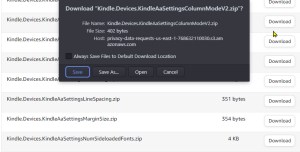
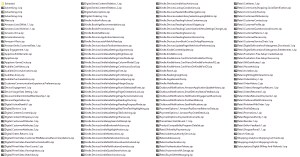
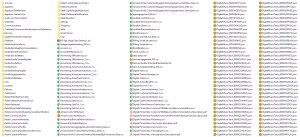

Here's some of what I found out:
 If you have communicated with any third-party merchants through Amazon, copies of the messages are retained. This is good in case you need to follow up with the merchant, Amazon, or anyone else later.
If you have communicated with any third-party merchants through Amazon, copies of the messages are retained. This is good in case you need to follow up with the merchant, Amazon, or anyone else later.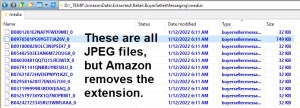 Amazon also retains any images you've included in messages to a seller. For reasons known only to Amazon, these are provided as files with no extension and no obvious way to determine what they are. I opened one of the files in a text editor and that provided the information I needed to identify it as an image file.
Amazon also retains any images you've included in messages to a seller. For reasons known only to Amazon, these are provided as files with no extension and no obvious way to determine what they are. I opened one of the files in a text editor and that provided the information I needed to identify it as an image file.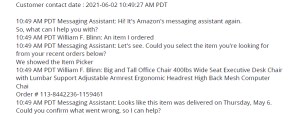 Communications with Amazon, either the automated assistant or a human support person are saved.
Communications with Amazon, either the automated assistant or a human support person are saved. Prime subscribers who use their subscriptions to watch videos will see a list that includes information about each episode's name, the series it was part of (if any), whether you watched on a computer or a television, and which internet service provider you were connected to.
Prime subscribers who use their subscriptions to watch videos will see a list that includes information about each episode's name, the series it was part of (if any), whether you watched on a computer or a television, and which internet service provider you were connected to.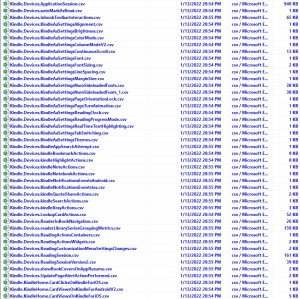 Many of the files appear to be from a relational database, but don't include the links needed to make the appropriate connections between the files. To examine your usage of Kindle ebooks, it's necessary to examine 44 files and try to figure out the connections between them. The full query results could be exported to a single CSV file that the customer could open in a spreadsheet program. You'll see this with other Amazon services, but the Kindle files illustrate most clearly what seems to be an overt attempt to make the process as difficult as possible for customers.
Many of the files appear to be from a relational database, but don't include the links needed to make the appropriate connections between the files. To examine your usage of Kindle ebooks, it's necessary to examine 44 files and try to figure out the connections between them. The full query results could be exported to a single CSV file that the customer could open in a spreadsheet program. You'll see this with other Amazon services, but the Kindle files illustrate most clearly what seems to be an overt attempt to make the process as difficult as possible for customers.Whether you look at a lot of the files or just a few, it's clear that Amazon knows a lot about its customers. That shouldn't be a surprise even if you look at none of the files or ignore the process entirely. It's not necessarily a bad thing. Stellar sales clerks know their customers and what their customers like. Stellar sales clerks may even call their best customers with information about something they know the person would like to have. Amazon has simply automated the process.
But even so, the stellar Amazon sales clerk seems to know far more about us than any human sales clerk ever could.
Microsoft has been working on changes for Microsoft 365, the new name for Office 365, so that its interface more closely resembles that of Windows 11, but that's not all.
Click any small image for a full-size view. To dismiss the larger image, press ESC or tap outside the image.
When you open one of the applications, you may be prompted to try the new interface. Perhaps you've already seen that message. Besides looking at what's new, I'll explain how you can restore the old interface if you've tried the new one and don't like it as well as how to enable the new interface if you initially declined the offer.
Microsoft has been testing the changes since the summer of 2021 with some Microsoft 365 and Office 2021 users. (And, no, I don't know why Microsoft dropped the "Office" designation for the software-as-a-service suite but retained it for the version with a perpetual license.)
Most of the visual changes are subtle, but more significant changes are coming. Microsoft would really like to have users start storing documents online, perhaps because more online usage means subscribers will need to pay for more online storage.
In promoting the changes, Microsoft says the new interface "will help you focus more on your work." What's missing is that there's no explanation of how or why the changes will allow users to focus more on their work. In fact, changes almost always have the exact opposite effect initially: The changes cause users to concentrate on the interface until they learn how to work with the changes.
That said, I like what I've seen so far. The interface will default to the settings you've established for the computer — light or dark — but this can be changed on the Account page. The options include black, white, dark gray, system, and "colorful".
The Quick Access Toolbar (QAT) can be hidden for those who dislike it. Any function on the QAT will also be found on the menu or ribbon, so it's understandable for it to be seen as unnecessary and a waste of space. But the QAT can be used to display commands that are several layers deep on a menu. For example, I prefer to work in Print view but sometimes need to switch to Outline view. Placing Print View and Outline View on the QAT allow for instantaneous one-click changes. Any command from any menu can be placed on the QAT.
The ribbon has a rounded look and the buttons have been modified in Word, Excel, PowerPoint, OneNote, and Outlook. In other words, the changes haven't been applied to all of the applications in the suite.
So if you tried the new interface and want to go back, or you ignored the offer and want to try, open Word, Excel, PowerPoint, OneNote, or Outlook and look for a megaphone in the upper right corner. Click it and then scroll down to the toggle switch. After turning the new features on or off, you'll need to restart the application.
But before deciding to go back, give the changes a chance for a few days.